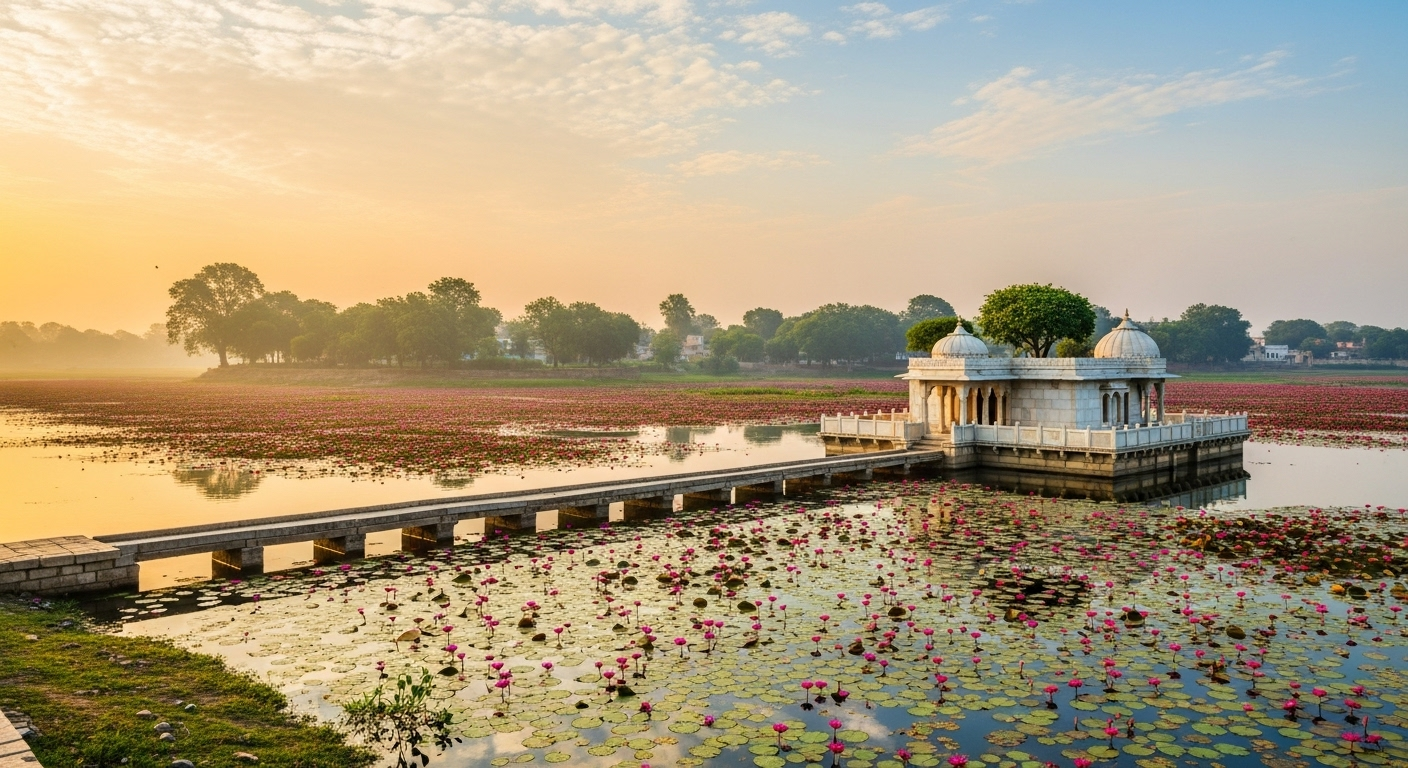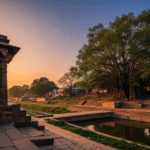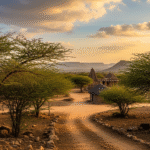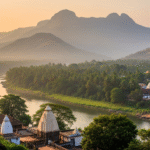Near the famous Kakolat Falls in Bihar, Pawapuri is more than just a town. It’s a place full of spiritual stories. Here, Lord Mahavira, an important figure in Jainism, found peace. This event is special but not well known.
Pawapuri stands out for its beautiful Jal Mandir, surrounded by a lotus pond. This pond was made by Mahavira’s followers during his cremation. It shows their love and respect for him.
Pawapuri is quiet but filled with stories of faith. Its silence carries old lessons. The waters reflect more than just images. They show Pawapuri’s holy stories.
Pawapuri: A Pilgrimage of Tranquility and Enlightenment
Key Takeaways
- Discover the profound legacy of Lord Mahavira amidst Pawapuri’s sacred environment.
- Learn about the Jal Mandir, a structural marvel symbolizing devotion and serenity.
- Immerse in the Pawapuri untold stories that resonate within the town’s tranquil ambiance.
- Understand the significance of Nirvana in Jainism as manifested in Pawapuri’s profound spirituality.
- Unearth the narrative of a humble town holding a monumental place in religious history.
Pawapuri: A Pilgrimage of Tranquility and Enlightenment
Pawapuri stands as a beacon of peace in Jainism. It is not just a destination but a journey into tranquility and enlightenment. Millions have found Enlightenment here, drawing seekers worldwide to walk in Lord Mahavira’s steps.
Journey into the Sacred Heart
Pawapuri offers serene landscapes and quietude. Its ancient stories and practices help seekers find spiritual awakening. Here, Lord Mahavira’s enlightenment inspires thoughts on detachment and renunciation.
The Celestial Pond of Jal Mandir
The Jal Mandir is central to Pawapuri’s experience. Surrounded by a celestial pond, this marble temple marks Lord Mahavira’s cremation spot. The white marble and tranquil waters symbolize purity and peace. Pilgrims encircle the temple, their chants and prayers thickening the air with devotion.
Significance of Nirvana in Jainism
Nirvana, or final liberation from rebirth, is key in Jainism. In Pawapuri, where Lord Mahavira achieved Nirvana, its significance is strong. It’s a core teaching here, touching those seeking understanding and release.
Pawapuri is more than a historical or religious site. It blends ancient tranquility with a quest for spiritual enlightenment. As a top Jain pilgrimage site, it shows the lasting power of faith and the timeless pursuit of enlightenment.
The Luminous Path of Lord Mahavira
In the calm place of Pawapuri, peace and spirit come together. Here, Lord Mahavira’s important lessons touch hearts deeply. His teachings about not hurting others, being truthful, and letting go of worldly things shape Jain beliefs over time.
Visitors and learners come to this holy place. They learn from stories about Lord Mahavira’s final days and how he reached Nirvana. These tales help them spiritually and connect them with Jain history. The Kamakhya Temple in Assam shows similar faith and history bonds.
Pawapuri is more than just a location. It’s a light of Jainism enlightenment. The wisdom found here helps both personal faith and scholarly work. Scholars study ancient texts to understand their effects on today’s world.
Following Lord Mahavira’s path in Pawapuri inspires both followers and scholars. It leads to freedom and deep understanding. Pawapuri’s peaceful but powerful presence makes this journey soul-opening.
Hidden stories of Pawapuri
Pawapuri is a special place in India’s spiritual history. It’s filled with peace and many important stories. These stories show deep devotion and wisdom. They reflect the core values of Jainism.
Lord Mahavira’s Last Teachings
Mahavira’s final teachings are key to Pawapuri’s history. This place, rich with history, heard his last words. His teachings focus on non-violence, truth, and living simply. These principles are very important to Jains.
The Creation of Jal Mandir
The creation of Jal Mandir is a fascinating story. When Mahavira passed away, his followers showed their love in a big way. They dug a lake at his cremation site and built a temple there. This showed their deep devotion.
The stories of Pawapuri and Jal Mandir are very meaningful. They are about more than just the past. They show the strength and values of a community. These stories inspire us to have deep faith and to work together.
A Glimpse into the Jain Spirituality and Rituals
The sacred practices of Jain spirituality shine brightly at Pawapuri. These Jain sacred practices show the deep beliefs of the Jains. They also help us understand their long-held traditions.
Pawapuri rituals are key for those in the Jain faith. They show the values of simplicity, purity, and kindness. These rituals are more than just worship. They show the deep identity of the Jains, kept alive for thousands of years.
At their core, these rituals honor Mahavira’s teachings. He was the last Tirthankara. His life and nirvana make Pawapuri very special. The rituals here range from quiet prayers to big offerings.
This shows Jain spirituality‘s big role at Pawapuri.
The stats below show how much people around the world want to know about Jainism and Buddhism:
| Focus Area | Percentage of Questions |
|---|---|
| Birthplaces of significant figures | 34% |
| Historical Context | 22% |
| Philosophical Aspects | 16% |
| Literature and Sacred Texts | 12% |
| Significant Historical Events | 8% |
| Symbols and Gestures | 4% |
| Influence of Buddhist Rulers | 4% |
This information shows the wide interest in these old religions. It covers many topics, from philosophy to significant places.
In the end, experiencing or watching the Pawapuri rituals connects us with an ancient spiritual path. It helps us see Jain spirituality and India’s spiritual story in a new way.
Amidst Legends and Folklore: The Local Lore of Pawapuri
The mystical town of Pawapuri is full of divine stories and colorful fun. It is important in Jain heritage. It has many tales from the past where myths and truth mix. This creates a tapestry of spiritual wonder. People get inspired by the origins of Pawapuri. They are tales of enlightenment and divinity.
Myths Surrounding the Origins of Pawapuri
The story of Pawapuri’s sacred beginning is full of mystery and miracles. It’s related to Lord Mahavira’s life. The Pawapuri folklore tells us about its sacredness. This came with the Nirvana of Lord Mahavira, the last Tirthankara. He left his mortal body here. After that, the land became holy right away. This place became more than a location. It became a spiritual center.
Festivals and Ceremonies: A Rich Cultural Fabric
The Jain festivals in Pawapuri are special. They do more than just celebrate. They weave into the community’s social and spiritual life. Each festival is full of religious meaning. They fill the town with colors, sounds, and collective worship. Big events include Mahavir Jayanti and Paryushan. During these times, Pawapuri becomes very important for Jains worldwide. This shows the strong connection between the divine and its followers.
| Festival | Significance | Celebration Period |
|---|---|---|
| Mahavir Jayanti | Birth of Lord Mahavira | March-April |
| Paryushan | Jain festival of repentance and forgiveness | August-September |
| Diwali | Marks the Nirvana of Lord Mahavira | October-November |
| Mauna Agyaras | Observance of silence, reflecting self-discipline and peace | November-December |
The Architecture of Faith: Understanding Pawapuri’s Jal Mandir
We start a special journey through the Jain temple design. Pawapuri’s Jal Mandir shows the heart of spiritual architecture. This lovely building shines a light on Jainism’s deep spirit. It brings people into a world of peace and faith. The temple is simple yet precise, floating like a dream on a lotus pond.
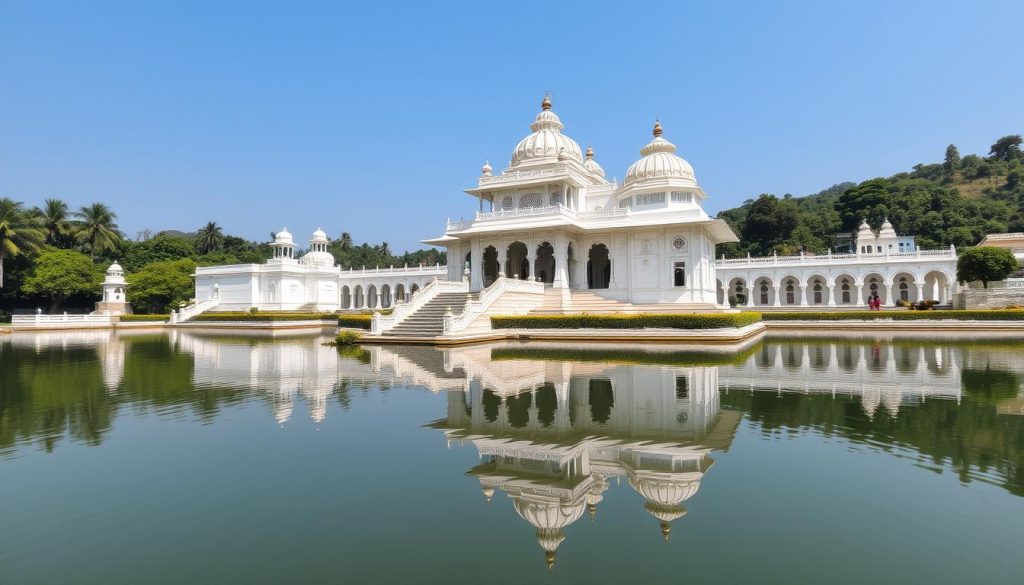
This temple is made of white marble. It stands for purity and peace. Its simple lines help people meditate and look within. The design shows the Jain way of living simply to find spiritual truth. It shows how Jain temple design uses nature to make a sacred place.
- Geometric symmetry representing the universe’s orderliness
- Minimalist aesthetic reflecting Jain principles of austerity
- Integration with natural elements like the surrounding water, enhancing the meditative quality of the site
Spiritual architecture tells the Jainism story with every detail. The temple’s design makes people think and find peace. The central shrine, where the idol sits, pulls everyone’s focus. This idea is key in Jain belief.
| Feature | Description |
|---|---|
| White Marble | Symbolizes purity and peace |
| Lotus Pond | Represents detachment, floating above the murk (worldly desires) |
| Central Shrine | Focuses attention and devotion inward, embodying Jain asceticism |
Pawapuri’s Jal Mandir is a deep symbol of Jain beliefs. It’s more than a building. It’s part of the spiritual path. It shows Jainism’s love and philosophy. This makes Pawapuri’s Jal Mandir a lasting sign of Jain architecture and spirit.
Pawapuri through the Ages: From Ancient Grandeur to Present Serenity
Exploring historical narratives of Pawapuri shows a shift from old sacred beginnings to today’s calm. This serene place has seen major spiritual and physical shifts throughout time. These changes show the evolution of Pawapuri.
Pawapuri’s Historical Narratives and Accounts
Ancient Pawapuri was once a bustling hub, known for Lord Mahavira’s enlightenment and Nirvana. Its rich history highlights key events. These have made it a holy place for Jains.
The Journey of Sanctity: The Evolution of a Holy Site
The story of Pawapuri reflects a move from Mahavira’s teachings to a symbol of peace. This journey shows how Jain beliefs have lasted over time. It’s a story of adapting and staying true to core values.
| Location | Google Rating | Unique Features |
|---|---|---|
| Bodh Gaya | 4.7 stars | Site of Buddha’s enlightenment |
| Patna | 4.5 stars | Rich historical city |
| Nalanda | 4.6 stars | Ancient university ruins |
| Vaishali | 4.4 stars | Site of Buddha’s last sermon |
| Madhubani | 4.5 stars | Famous for vibrant Mithila paintings |
In summary, Ancient Pawapuri has kept its history alive while becoming a peaceful retreat. It remains important to visitors, admirers, and spiritual seekers, securing its place as a tranquil haven.
The Resonance of Pawapuri in Jain Literature and Art
The site of Lord Mahavira’s liberation, Pawapuri, is crucial in Jain art and literature. It marks where he achieved moksha. Through Jain scriptures, it shines, mixing history with divine stories. Every mention of Pawapuri in Jain literature shows its deep link with Jain teachings.
Pawapuri’s influence is also seen in its visual depiction. Jain artists capture scenes that show peacefulness and spirituality. This place is more than a town. It’s about peace and enlightenment. Many art pieces feature Mahavira’s last sermon and his nirvana. This highlights Pawapuri’s cultural impact.
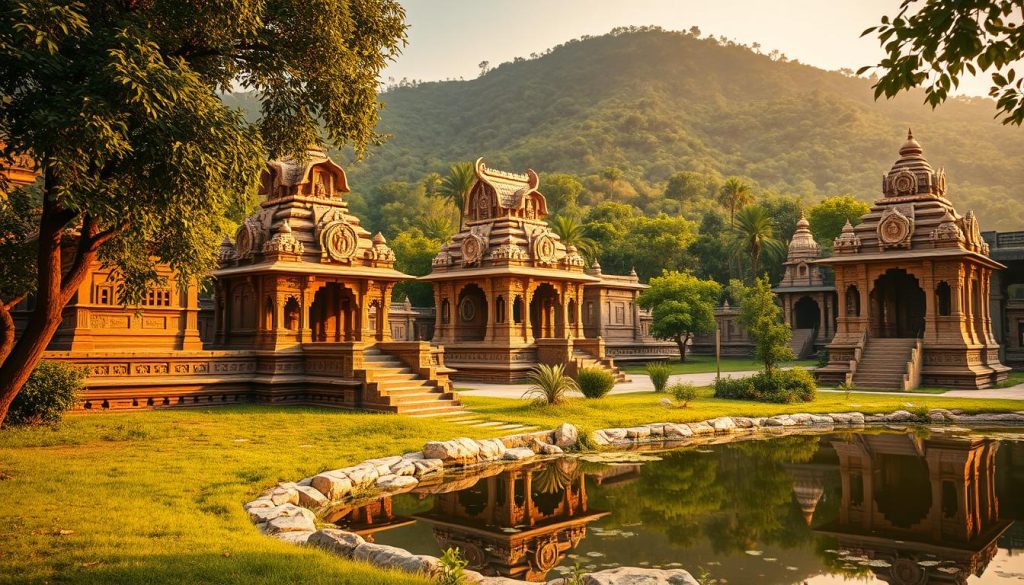
Pawapuri’s symbolism reaches far in shaping Jain identity. Here’s how:
| Aspect | Impact on Literature | Impact on Art |
|---|---|---|
| Iconography | Texts describe Mahavira’s last day in detail. | Art shows lotus and temple symbols for Pawapuri. |
| Narratives | There are stories about Mahavira’s teachings and his followers. | Paintings and sculptures show important moments of Mahavira. |
| Cultural Significance | Texts see Pawapuri as a key pilgrimage spot that inspires virtues. | Art reflects Pawapuri’s vital role in Jainism. |
In conclusion, Pawapuri’s role in Jain literature and art is timeless. It symbolizes Jain culture and faith. Each work honors spiritual success and cultural pride. It’s not just a location but a shared memory and respect, represented by both writers and artists.
Conclusion
Pawapuri is a place that tells stories beyond simple events from the past. It’s where Lord Mahavira found enlightenment. People from all around the world feel a spiritual pull to this place. Pawapuri’s peace and spirituality make it special.
The calmness here, mixed with Pawapuri’s hidden stories, makes people see it as a peace symbol. It helps people find themselves in silence and reflection.
Visiting Jal Mandir or learning Jainism’s customs, people find spiritual freedom. The beautiful buildings are not just pretty. They show where many have walked on their spiritual journeys.
The peace in Pawapuri’s temples and rituals tells a story of deep faith. This town is very important in Jain art and literature. It inspires a lot of respect. Pawapuri is more than just a place. It invites us to look deep inside. It helps us find the enlightenment that Lord Mahavira talked about long ago.
FAQ
What are the hidden stories of Pawapuri?
Pawapuri holds tales full of wonder and history. Stories tell of Lord Mahavira’s enlightenment and Nirvana here. Legends also say how his followers created the Jal Mandir in his honor. These tales reflect the town’s deep spiritual essence.
Why is Pawapuri an important site for Jain pilgrims?
Pawapuri is special because Lord Mahavira, a key figure in Jainism, found Nirvana there. Its temples like the Jal Mandir offer a peaceful place for pilgrims. They come seeking spiritual growth.
What is the significance of Jal Mandir in Pawapuri?
Jal Mandir stands beautifully on a lotus pond in Pawapuri. It’s where Lord Mahavira was cremated. His followers dug up the pond to keep his relics. It’s a worship place that shows Jain values of purity.
How does Nirvana feature in the context of Pawapuri and Jainism?
Nirvana means breaking free from rebirth in Jainism. It’s the highest spiritual aim. Pawapuri is where Lord Mahavira reached Nirvana. So, it’s a beacon for those seeking this freedom too.
Can you tell me more about Lord Mahavira’s teachings at Pawapuri?
In Pawapuri, Lord Mahavira taught important Jain values. He spoke of nonviolence, truth, and letting go of worldly desires. His teachings there shape Jain philosophy deeply.
What myths are associated with the origins of Pawapuri?
Myths about Pawapuri link it closely to Lord Mahavira and Jainism. One story says gods chose it for Mahavira’s final sermon. Another talks of a pond made by followers mourning Mahavira, wanting his relics.
How are festivals and ceremonies celebrated in Pawapuri?
Festivals in Pawapuri showcase Jain culture with processions and prayers. They honor Lord Mahavira and other spiritual leaders. These moments strengthen the Jain community’s bond and faith.
How does the architecture of Jal Mandir reflect Jain principles?
Jal Mandir’s architecture reflects Jain beliefs in its simplicity and natural setting. Its minimalist design and surrounding waters suggest deep Jain values. They encourage reflection and purity.
What unique historical narratives does Pawapuri hold?
Pawapuri has a rich history from Mahavira’s time to becoming a pilgrimage site. Stories of ancient teachings and temple building show its evolution. They highlight its lasting importance.
How is Pawapuri represented in Jain literature and art?
Jain art and literature often depict Pawapuri’s sacredness and Lord Mahavira. They celebrate its spiritual significance. Through these works, Pawapuri’s legacy lives on, cherished by Jains.
